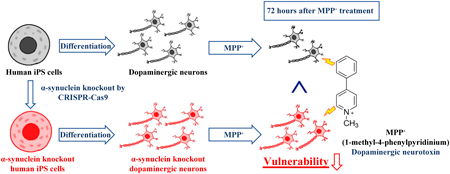- 著者
- Aina Fukuda Souichi Nakashima Yoshimi Oda Kaneyasu Nishimura Hidekazu Kawashima Hiroyuki Kimura Takashi Ohgita Eri Kawashita Keiichi Ishihara Aoi Hanaki Mizuki Okazaki Erika Matsuda Yui Tanaka Seikou Nakamura Takahiro Matsumoto Satoshi Akiba Hiroyuki Saito Hisashi Matsuda Kazuyuki Takata
- 出版者
- The Pharmaceutical Society of Japan
- 雑誌
- Biological and Pharmaceutical Bulletin (ISSN:09186158)
- 巻号頁・発行日
- vol.46, no.2, pp.320-333, 2023-02-01 (Released:2023-02-01)
- 参考文献数
- 69
Alzheimer’s disease (AD) is a progressive neurodegenerative disease characterized by dementia. The most characteristic pathological changes in AD brain include extracellular amyloid-β (Aβ) accumulation and neuronal loss. Particularly, cholinergic neurons in the nucleus basalis of Meynert are some of the first neuronal groups to degenerate; accumulating evidence suggests that Aβ oligomers are the primary form of neurotoxicity. Bacopa monniera is a traditional Indian memory enhancer whose extract has shown neuroprotective and Aβ-reducing effects. In this study, we explored the low molecular weight compounds from B. monniera extracts with an affinity to Aβ aggregates, including its oligomers, using Aβ oligomer-conjugated beads and identified plantainoside B. Plantainoside B exhibited evident neuroprotective effects by preventing Aβ attachment on the cell surface of human induced pluripotent stem cell (hiPSC)-derived cholinergic neurons. Moreover, it attenuated memory impairment in mice that received intrahippocampal Aβ injections. Furthermore, radioisotope experiments revealed that plantainoside B has affinity to Aβ aggregates including its oligomers and brain tissue from a mouse model of Aβ pathology. In addition, plantainoside B could delay the Aβ aggregation rate. Accordingly, plantainoside B may exert neuroprotective effects by binding to Aβ oligomers, thus interrupting the binding of Aβ oligomers to the cell surface. This suggests its potential application as a theranostics in AD, simultaneously diagnostic and therapeutic drugs.
- 著者
- Shizen Inoue Kaneyasu Nishimura Serina Gima Mai Nakano Kazuyuki Takata
- 出版者
- The Pharmaceutical Society of Japan
- 雑誌
- Biological and Pharmaceutical Bulletin (ISSN:09186158)
- 巻号頁・発行日
- vol.46, no.3, pp.517-522, 2023-03-01 (Released:2023-03-01)
- 参考文献数
- 20
- 被引用文献数
- 3
Parkinson’s disease (PD) is an age-related disorder with selective dopaminergic (DA) neuronal degeneration in the substantia nigra pars compacta. The presence of mainly α-synuclein-composed Lewy bodies in DA neurons is among the disease hallmarks in the brain of patients with PD. Human induced pluripotent stem cells (hiPSCs) are powerful tools to investigate PD pathophysiology and understand its molecular and cellular mechanisms better. In this study, we generated an α-synuclein-null hiPSC line introducing a nonsense mutation in the α-synuclein-encoding SNCA alleles using clustered regularly interspaced short palindromic repeats CRISPR-associated protein 9 (CRISPR-Cas9)-mediated gene editing. Our Western blotting analysis revealed the lack of α-synuclein protein expression in SNCA knockout hiPSC-derived cells. In addition, SNCA knockout hiPSCs retained healthy cell morphology, undifferentiated marker gene (e.g., NANOG, POU5F1, and SOX2) expression, and differentiation ability (based on the marker gene expression levels of the three germ layers). Finally, SNCA knockout hiPSC-derived DA neurons exhibited reduced vulnerability to the DA neurotoxin, 1-methyl-4-phenylpyridinium. In conclusion, the SNCA knockout hiPSC line we generated would provide a useful experimental tool for studying the physiological and pathological role of α-synuclein in PD.
1 0 0 0 OA Therapeutic Application of Stem Cell Technology toward the Treatment of Parkinson’s Disease
- 著者
- Kaneyasu Nishimura Jun Takahashi
- 出版者
- The Pharmaceutical Society of Japan
- 雑誌
- Biological and Pharmaceutical Bulletin (ISSN:09186158)
- 巻号頁・発行日
- vol.36, no.2, pp.171-175, 2013-02-01 (Released:2013-02-01)
- 参考文献数
- 41
- 被引用文献数
- 27 37
Parkinson’s disease (PD) is one of the candidate diseases for cell transplantation therapy, since successful clinical experiments have accumulated using human fetal tissue grafting for PD patients. Although some grafted PD patients have shown drastic improvements, several issues still remain with regard to using human fetal tissue. This review highlights the recent advances in stem cell technology toward clinical applications using human pluripotent stem cells. In particular, pluripotent stem cells, such as embryonic stem cells and induced pluripotent stem cells (iPSCs), are the focus as a source of cell transplantation therapy that can be used instead of human fetal tissues. Additionally, efficient methods for stem cell maintenance and differentiation have been developed and improved toward the clinical transition. These advances in the basic technologies have helped accelerate the realization of regenerative medicine. We also review the current topics regarding disease modeling and drug screening using iPSC technology. Finally, we also describe the future prospects of these stem cell research fields toward clinical application.

